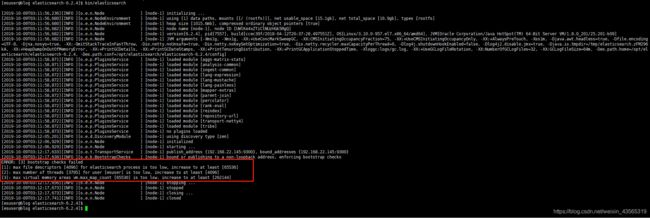elasticsearch项目开发-elasticsearch6.2.4环境搭建
ES开发环境搭建
背景
目前公司在做巡视整改项目,需要全文检索功能。所以把自己学习并在实践中遇到的问题记录下来,共同学习和进一步加深对es的了解。
了解Elasticsearch
你知道的,为了搜索…
推荐
Elasticsearch学习,请先看这一篇!
环境准备
我是在VMware虚拟机中操作
- CentOS7
- jdk1.8
- elasticsearch6.2.4
一. CentOS7系统配置java运行环境
-
jdk1.8 tar.gz包下载:
https://www.oracle.com/technetwork/java/javase/downloads/jdk8-downloads-2133151.html -
解压tar.gz包(在这我把jdk1.8的tar包放在linux目录/opt/java/下):
tar -xzvf jdk1.8.0_201.tar.gz -
配置环境变量:
vi /etc/profile 在/etc/profile文件里加入下面代码 export JAVA_HOME=/opt/java/jdk1.8.0_201 export PATH=.:$JAVA_HOME/bin:$PATH export CLASSPATH=.:$JAVA_HOME/lib/dt.jar:$JAVA_HOME/lib/tools.jar -
刷新刚配置好的profile文件:
source /etc/profile -
检查是否配置成功:
java -version 出现下面版本信息说明配置成功 java version "1.8.0_201" Java(TM) SE Runtime Environment (build 1.8.0_201-b09) Java HotSpot(TM) 64-Bit Server VM (build 25.201-b09, mixed mode)
二.搭建elasticsearch6.2.4服务
-
下载elasticsearch6.2.4.tar.gz包:
https://www.elastic.co/cn/downloads/past-releases/elasticsearch-6-2-4 -
解压tar.gz包(在这我把tar包放在linux目录/opt/elasticsearch/下):
tar -xzvf elasticsearch-6-2-4.tar.gz -
在这里先修改一下es配置文件(vi /opt/elasticsearch/elasticsearch-6-2-4/config/elasticsearch.yml)
# ======================== Elasticsearch Configuration =========================
#
# NOTE: Elasticsearch comes with reasonable defaults for most settings.
# Before you set out to tweak and tune the configuration, make sure you
# understand what are you trying to accomplish and the consequences.
#
# The primary way of configuring a node is via this file. This template lists
# the most important settings you may want to configure for a production cluster.
#
# Please consult the documentation for further information on configuration options:
# https://www.elastic.co/guide/en/elasticsearch/reference/index.html
#
# ---------------------------------- Cluster -----------------------------------
#
# Use a descriptive name for your cluster:
#集群名
cluster.name: elasticsearch
#
# ------------------------------------ Node ------------------------------------
#
# Use a descriptive name for the node:
#当前节点名
node.name: node-1
#
# Add custom attributes to the node:
#
#node.attr.rack: r1
#
# ----------------------------------- Paths ------------------------------------
#
# Path to directory where to store the data (separate multiple locations by comma):
#当前节点索引数据保存的路径
path.data: /opt/elasticsearch/data
#
# Path to log files:
#保存日志的路径
path.logs: /opt/elasticsearch/logs
#
# ----------------------------------- Memory -----------------------------------
#
# Lock the memory on startup:
#设置为true来锁住内存。因为当jvm开始swapping时es的效率会降低,所以要保证它不swap,可以把ES_MIN_MEM和
#ES_MAX_MEM两个环境变量设置成同一个值,并且保证机器有足够的内存分配给es。
#同时也要允许elasticsearch的进程可以锁住内存,linux下可以通过ulimit -l unlimited命令。
#bootstrap.memory_lock: true
#
# Make sure that the heap size is set to about half the memory available
# on the system and that the owner of the process is allowed to use this
# limit.
#
# Elasticsearch performs poorly when the system is swapping the memory.
#
# ---------------------------------- Network -----------------------------------
#
# Set the bind address to a specific IP (IPv4 or IPv6):
#虚拟机ip地址
network.host: 192.168.22.145
#
# Set a custom port for HTTP:
#端口
http.port: 9200
#
# For more information, consult the network module documentation.
#
# --------------------------------- Discovery ----------------------------------
#
# Pass an initial list of hosts to perform discovery when new node is started:
# The default list of hosts is ["127.0.0.1", "[::1]"]
#设置集群中的主节点的初始列表,能自动发现列表中节点启动
#我这里配置的是单机
discovery.zen.ping.unicast.hosts: ["192.168.22.145"]
#discovery.zen.ping.unicast.hosts: ["192.168.22.143","192.168.22.144","192.168.22.145"]
#
# Prevent the "split brain" by configuring the majority of nodes (total number of master-eligible nodes / 2 + 1):
#设置这个参数来保证集群中的节点可以知道其它N个有master资格的节点。
#默认为1,对于大的集群来说,可以设置大一点的值(2-4)
#discovery.zen.minimum_master_nodes:
#
# For more information, consult the zen discovery module documentation.
#
# ---------------------------------- Gateway -----------------------------------
#
# Block initial recovery after a full cluster restart until N nodes are started:
#设置集群中N个节点启动时进行数据恢复
#gateway.recover_after_nodes: 3
#
# For more information, consult the gateway module documentation.
#
# ---------------------------------- Various -----------------------------------
#
# Require explicit names when deleting indices:
#
#action.destructive_requires_name: true
-
简单配置完已经可以准备运行了
cd elasticsearch-6-2-4/ //启动 bin/elasticsearch
启动报错 can not run elasticsearch as root
es启动时不能用root用户,所以新建一个es启动的用户,并赋权限:
1.创建es用户
useradd esuser
2.给esuser添加密码
passwd esuser
3.给esuser赋予操作elasticsearch-6-2-4文件夹的权限(我有关es的文件都放在elasticsearch就直接赋予esuser操作elasticsearch权限)
chown -R esuser:esuser /opt/elasticsearch
4.切换esuser用户
su esuser
做完上面操作,再次启动es
bin/elasticsearch
[1]: max file descriptors [4096] for elasticsearch process is too low, increase to at least [65536]
原因是当前操作用户最大可创建文件数太小,无法创建,给它增加就完事了。
先切换到root用户
su root
然后编辑limits.conf文件
vi /etc/security/limits.conf
在limits.conf文件最后添加
* hard nofile 65536
* soft nofile 65536
[2]: max number of threads [3795] for user [esuser] is too low, increase to at least [4096]
原因是当前用户esuser的最大线程数为3795太小了,也给它增加
切换到root用户
su root
然后编辑20-nproc.conf文件
vi /etc/security/limits.d/20-nproc.conf
在20-nproc.conf文件添加
* soft nproc 4096
* hard nproc 4096
[3]: max virtual memory areas vm.max_map_count [65530] is too low, increase to at least [262144]
原因是当前虚拟内存太小,给它增加
切换到root用户
su root
在/etc/sysctl.conf文件最后添加一行
vm.max_map_count=262144
重启虚拟机
以上问题解决后切换到esuser用户在启动
bin/elasticsearch

这回不在报错,然后访问在配置文件设置的http://192.168.22.145:9200
至此es服务启动成功。
es环境简单搭建好,下一步在进行elasticsearch-head图形化界面插件安装。
参考文档
Elasticsearch: 权威指南
ELK学习系列文章第二章:elasticsearch常见错误与配置简介


